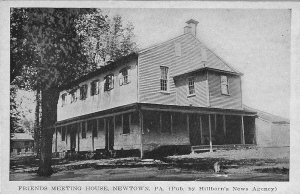 Newtown was founded by William Penn in 1684, and its early settlers were mostly Quakers. Newtown quickly became a major road hub and a destination of such importance that it was made the county seat in 1727. But no Friends Meeting was established here until after the county seat was moved to Doylestown in 1813. In 1815, Newtown Friends was established, and under Edward Hicks’ leadership, took over the abandoned courthouse as their place of worship. The first members were transfers from Wrightstown and Middletown meetings.
Newtown was founded by William Penn in 1684, and its early settlers were mostly Quakers. Newtown quickly became a major road hub and a destination of such importance that it was made the county seat in 1727. But no Friends Meeting was established here until after the county seat was moved to Doylestown in 1813. In 1815, Newtown Friends was established, and under Edward Hicks’ leadership, took over the abandoned courthouse as their place of worship. The first members were transfers from Wrightstown and Middletown meetings.
When the community decided it was to time to build their own meetinghouse, it is told that seven wealthy Friends pledged to build it by private subscription. No record of the cost of the meetinghouse can be found; however, member Judge Michael H. Jenks said that he and his grandfather, Joseph Jenks distilled a quanity of apple whiskey and sold it to raise the $100 they had subscribed toward the building, as reportedly did some others.
The main part of the meetinghouse was built in 1817, on Court Street, on two acres brought from Dr Phineas Jenks for $60. The meetinghouse, 40’x60′, was a plain, oblong structure of stone, two stories high, and was built on the typical lines of most Friends meetinghouses of the time, with two entrances facing south and sliding shutters inside running north and south divided the men’s (west) and women’s (east) sides, affording two almost identical meeting rooms for business when closed. At the time, women transacted their own business and kept their own minutes, but when the shutters were opened all were united in meetings for worship. Additionally, there was a raised gallery for the ministers and elders on the north side (the facing benches).
In December 1892, for the first time, men and women held combined business meetings. In 1926, Newtown evolved from a Preparative meeting to a Monthly Meeting. In 1947, Newtown Friends School was founded by meeting Friends.
South of the meetinghouse is the graveyard where the first burial took place in 1820. Edward Hicks, renowned painter and Quaker minister was the first minister to speak in the meetinghouse; he was a member and a prominent minister of Newtown Meeting from its inception until his death. He is buried in the graveyard, his white headstone, located under the large sycamore tree.
Additions and improvements have been made to the property throughout the years. These have included:
- 1819: Horse sheds were erected just north of the meetinghouse.
- 1868: The south porch was added.
- 1904: The second story over the benches of the main body and the eastern and western benches was floored, and sliding glass windows were installed that could be raised so worshipers seated upstairs could look down through a ‘well’ to the facing benches where the elders and ministers were seated below, and the stairways were built in the southeast and southwest corners.
- 1911: The first kitchen was installed, on the second floor on the east end, centered over the porch.
- 1952: Physical improvements were made by building on each side of the kitchen – a classroom for the First Day School, a men’s toilet room and a modern women’s lavatory was also provided.
- 1957: The addition of a new First Day School annex, comprising five First Day School Rooms, a new kitchen and a complete new heating system for both. A fire damaged part of the meeting room; paint, benches, hymnals.
- 2005: New addition
We continue to upgrade and modernize our meetinghouse. Renovations have included replacing most of the meeting room’s unstable hardwood floors with carpet and replacing the green bench cushions with our current burgundy cushions. In 2005, the newest addition was completed; this involved tearing down the classrooms built in 1947 and replacing them with a spacious, two story lobby, home to our collection of Edward Hicks reproductions, a first floor gathering room, an updated kitchen, a large handicap accessible bathroom, and a dedicated room for committee meetings. The balcony area received a much needed facelift: the walls were painted and new carpet installed, and the old dividers were cleaned and reinstalled on their tracts to form the current First Day School classrooms. The childcare room above the lobby was also refurbished.
We are blessed that our meeting continues to be an active, evolving and vibrant community.
Centennial of Newtown Friends Meeting 1815-1915- a collection of papers read at the celebration.
A Brief Biography of Primitive Painter Edward Hicks.
Prominent folk artist Edward Hicks was beloved by this meeting for his spiritual leadership.
Kingdon Swayne’s 1980 Meeting History
Kingdon Swayne, former clerk of Newtown Monthly Meeting and former mayor of Newtown, posed a surprising hypothesis on why it took so long for Quakers to create a meeting house in a town that was laid out in 1684 by William Penn, Pennsylvania’s most prominent Quaker. On the other hand, Kingdon Swayne is dumbfounded as to why Quakers painted the interior in 1889.
Lois Mammel’s History of Newtown Meeting: In 1976, Lois Mammel compiled the historical data that would qualify Newtown Monthly Meeting as an historical site in 1977. Her narrative explains the unusual configuration of windows overlooking the center of the meeting. She also touches on intriguing bits of history: the role of Edward Hicks, the reason Hicks’ tombstone is ordinary, and the waning of singsong ministry.
Our Meetinghouse is on the Newtown Heritage Walk. The Meeting sponsored signs for Newtown Friends Meeting, and the Edward Hicks House.